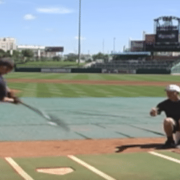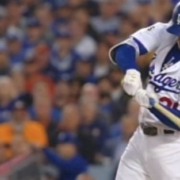Batting Timing Drills For Baseball & Softball | BEST 2022 Youth Beginner Rhythm Hitting Drills And Swing Tips | Fresno, California
We discuss the BEST baseball, fast-pitch softball, and slow-pitch softball batting timing drills. Revealed are our favorite youth beginner rhythm hitting drills and swing tips. We’re based out of Fresno, California.
The Sooner You Know These Batting Timing Drills The Better
Take a guess at one of the biggest hitting frustrations is, according to my readers? Timing! Probably not a shocker because your hitters probably struggle with this as well. Mine do, especially at the start of the season.
This batting timing drills for hitting a baseball and softball video guide will also have information useful to anybody facing the challenge of fixing a hitter with a late swing, getting a kid to swing earlier or sooner, and when to start front foot swing timing.
I always tell my hitters, the most effective mechanics in the world don’t mean a thing, if a hitter CANNOT get “on-time”. In a survey, my readers asked if I use any batting timing drills with my hitters – that work?
Funny, because…
Last week, I was on a call with one of my online lesson dads from Southern California. He said the difference in his son hitting the ball harder, with more consistency, has been because of how we cue one of the batting timing drills I’m about to share with you.
SCIENCE-BASED TRAINING:
Improve your hitting strategy dramatically by applying human movement principles.
Learn not only how and what to train but also the science behind the methods.
Before we get started…
I want you to note that the following two batting timing drills are validated by empirical studies in the science of successful learning. They follow the Principle of Variance (CLICK HERE for a post that explains that).
In this post, I want to share the:
- “Float” Variance Drill, AND
- Reaction Time Variance Drill (aka, the “2-plate” drill).
Watch this Carlos Pena video on how a hitter’s reaction time changes with pitch location…
“Float” Variance Drill
Basically, a “float” is a slight pause before falling forward. Make sure you’re cuing “load slow and early”. This is what helped my SoCal hitter from above. CLICK HERE for this post referencing how Jose Bautista turned his swing around with the same cue.
We want the hitter to pick the stride foot up and shift their weight back. Which means the back knee will have to track over the back toe – and not inside. How far the back knee tracks depends on whether the hitters has a:
- High leg kick,
- Medium leg kick, or
- Slide step/toe tap.
The higher the leg kick, the more the back knee tends to track over the ankle. The knee shifts inside the toe during the fall. And this should be a natural move. It’s difficult for hitters to get “on-time” by just picking up the stride foot and falling forward.
And this is what would happen if the hitter focused solely on keeping the back knee inside the toe pre-stride foot lift. Don’t believe me? Check out this rant post I did on this.
If you still don’t believe me, then do an experiment with the drill, and have your hitters note the difference in their quality of contact and control swinging the bat. This also requires a strengthening of the leg abductors and adductors. Here’s the movement prescription to do that…
Side Band Walks (http://gohpl.com/1G1FlS5)
- Week one: 1 set X 10-yard walk both ways,
- Week two: 1 set X 15-yard walk both ways,
- Week three: 2 sets X 10-yard walk both ways, &
- Week four: 2 sets X 15-yard walk both ways.
Do once daily. Increase band resistance if necessary. Also, the above video demonstrates a semi-leg kick for the drill, this is necessary. The hitter can use any stride tip with the ‘float’. CLICK HERE for a post on different stride types. When to lift the stride foot to start the “float”, will get fleshed out in the next batting timing drill…
Reaction Time Variance Challenge (aka the “2-plate” drill)
In the past, part of my timing training, was to tell my hitters to lift their stride foot at a specified point in the pitcher’s delivery.
Which is okay.
But now, my batting timing drills put more emphasis on trial-by-fire. Let me put my hitter through an environment where they have to learn to calibrate their own timing. I’m trying to melt them down mentally. And they’re trying to keep me from melting them down.
In a game, the same thing happens. To help hitters transfer grooved cage swings into games, we have to train with “random” versus “massed” practice. It has to do with the process of “Read, Plan, Do”.
In other words, this batting timing drill “takes care of business”, in a natural way.
Please post any other batting timing drills – like these – that are working for your hitters in the “Leave a Reply” section below (or share your testing on the drills I included)…
- Master Your Swing: How to Choose the Best Baseball Hitting Training Videos for Immediate Skill Boost - February 28, 2024
- Mastering Advanced Baseball Techniques: Personalized Online Coaching Elevates Youth & High School Hitting Skills - January 17, 2024
- Master the Art of Batting by Doing the Opposite of What You Think - January 16, 2024












Great post ! I have one point to make and wondering what your thought is on letting the back knee go over the back toe.
I think the float works a lot better when the back knee stays inside the toe. With that being said, I agree lift and going forward is harder to time than going back first; makes timing easier. However, I want best of both worlds by letting my hitter
to shift weight back BUT still keep knee inside back toe. Almost like pressing into the ground with back foot enables you to have that slight pause. You want that natural move forward, but back knee over the toe makes it harder to control and can affect head/vision problems. I learn so much from your material. Thanks Joey!
Andy, great question. I don’t force my hitters to keep the back knee inside the back toe. For some, this can cause undue stress to the ligaments in the knee. I prefer to have them create torque in the back hip by turning the back toe slightly in towards the pitcher and feel like they’re screwing their ankle into their foot – clockwise for a righty, and counter-clockwise for a lefty. The back knee will most likely track the toes doing this, but the backside will be in a better more stable position.
Hey Joey,
Can you use front toss on the variance drill or only live arm? The mass practiced method I’ve employeed over the years with many different baseball teams has taken its toll on my arm.
Kevin, of course you can! I know what you mean there.
Does this back knee action during the “float” occur because of the anatomical structure of the knee? Ted Williams did it without the high leg lift but with the cocking of his front knee.
Joe, it happens because I’m creating torque in the back hip. Experiment with it yourself. Williams was probably doing the same thing. I’ve even seen Matt Kemp do this, even with him “trying” to keep his back knee inside his toes: https://www.youtube.com/watch?v=4Mtj8bMLqZk
You mean the rear side pelvis being pushed toward the dugout during the load as the front shoulder comes down and in? Then the rear pelvis snaps forward as the foot plants as the front side pelvis goes back.in the video I emailed you you can see Williams really do that.
Joe, I know Williams turned his pelvis inward toward the catcher to “load”, but it isn’t a necessary motion. Science says the way you load the front/back Functional Lines (Thomas Myers in his book Anatomy Trains) is to take the front shoulder in and down towards the back hip. If the hitter inwardly rotates the pelvis towards the catcher too, then the Front Fascial Line never gets fully charged. I say to keep the pelvis in neutral (or parallel to the plate), and focus on taking the front shoulder in and down. The point is that the hitter charges the connective tissue pre-turn and gets the front leg open at landing…anything in-between is fine.
Is the float drill used with a tee, or front toss, or dry swing?
Thanks, Mike P.
All of the above Mike 🙂
I wasn’t referring to the pelvis on the front side but the back side pelvis.
Great post ! Now I feel vindicated . Since the boys were 7 years old , I have always warmed the team up with weighted balls because there are not always batting cages . Even though the instructions say to throw underhand I learned to throw them overhand and would really bring it . I would sit on a bucket so my release point was similar to what they are seeing in games . I would give them a full windup and knee kick . Throwing from 15 feet , I could simulate a fastball and changup timing . It was tough and it simulated a 65mph fastball and 50mph change up . There was no arc in the pitch . It was almost real live conditions . I bought 30 weighted rubber balls . I would give them 10fastballs and the rest fastball /changup every other pitch. At first they almost all would still get fooled and out front on a changup count and I would ask them how could they get fooled on a change up that they knew was coming? They eventually learned . I would also focus on them hitting the bucket of balls right in front of me on a line drive . If they hit it so many times on a line drive , then I would buy them a snow cone .
I did this routine before every game. We ended up winning 3 legitimate World Series , two major state championships and came in 2nd place in two major state championships . Everyone thought I was crazy but there was a considerable difference in how they hit when we did this routine and when we did not . Our boys had way more power than other teams because of them used to hitting weighted balls and they drove the balls right up the middle of the field because of the snow cone incentive and they were able to anticipate , recognize and hit off speed conditions and pitches and keep their weight back in a float . Paid off!! Now they are big shot high schoolers and know everything. I’m pretty much just a fan now.
Bravo Coach Martin! Keep up the good work 😀
Joey, I am a softball coach and love your videos. My question on the timing has always been when to start the load. With the float, should they start on windup and kind of hold it before getting the front foot down?
Coach Paula, when to start the loading phase of the swing will depend on the hitter’s type of Float and stride. For example a high leg kicker will have to start sooner than a slide stepper. In FP softball, we’re dealing with shorter pitching distances and reaction times, so I’d recommend starting the hitter in the Catapult Loaded Position, then have them maintain it through the Float and Fall. In this post, the best hands off (for coaches) approach to re-calibrating a hitter’s timing is the Varied Reaction LIVE Toss Timing Drill. I reserve feedback until after a 5-swing round, and after about 3-5 rounds, my hitters have adjusted their timing.
I really like your varied reaction drill! I use this same principle with some of the younger boys I coach. I call it the three plate drill to simulate fast medium and slow pitchers. I like it when doing front toss it keeps the boys from getting to mechanical. The middle plate the boys start their load out of the hand, back plate they load when it crosses the front plate and the font plate they load on the split. It may vary a bit depending on the tempo of their swing but gets boys thinking and understanding what it’s going to take to be on time! Simple drill that has been really helped out.
Great job Ryan!